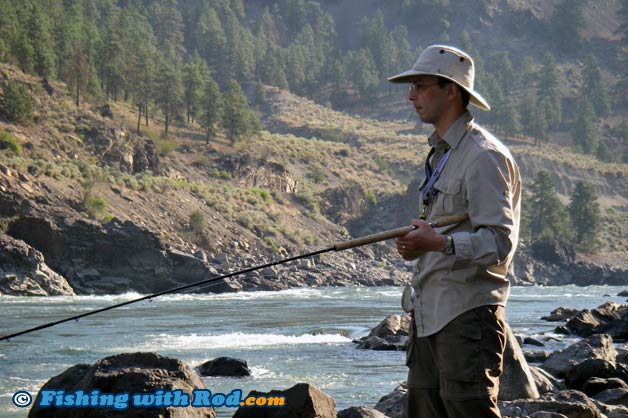Thompson River, Spences Bridge to Lytton
By Rodney Hsu

The Thompson River is a large tributary of the Mid Fraser River. It begins at Kamloops Lake and feeds into the Fraser River near Lytton. This guide specifically focuses on the section between Spences Bridge and Lytton. Some fishing opportunities are available in this stretch of the Mighty Thompson, but it is a fishery that is mostly participated by experienced anglers. Difficult terrain and turbulent water along the lower stretch of the river can be quite intimidating. That being said, with some careful exploration, you can find some excellent trout and salmon fishing at times. Combining it with camping at one of the provincial parks along the river, this driest and hottest part of British Columbia can be an ideal holiday stop-over for families.
How to Get There?
This stretch of Thompson River runs along Trans-Canada Highway from Lytton to Spences Bridge. Along the way, there are several provincial parks (Goldpan, Skihist) where you can spend the day or camp for the night. Access to the river can be difficult due to the steep terrain as the river reaches the confluence with the Fraser River. Great care should be taken to avoid any dangerous situation. The river downstream from Spences Bridge has better access due to the wider and flatter valley.
Fishing Season
From mid July to mid September, rainbow trout fishing can be very productive if river condition cooperates. The river is typically high in early July, but you will often find rainbow trout feeding close to shore under these conditions. As river level drops, trout feeding takes place further away from shore. The areas just downstream from Spences Bridge are the ideal spots for trout fishermen.
Salmon fishing opportunities are usually available from early August to mid September, depending on openings announced by Fisheries and Oceans Canada. Adult chinook salmon are usually not open for retention, but chinook jacks (under 50cm) are often open for retention. These tasty smaller fish are often targeted in this section of the Thompson River as they just arrive from the Fraser River. During years of high sockeye and pink salmon returns, they are also sometimes open for retention. The best way to find out when these openings are is to check the fishery notices or ask your local tackle stores.
The famous Thompson River steelhead fishery usually begins in October, but announcements of the opening are usually made in the last minute so you need to check the ministry's website for updates.
Fishing Techniques
When fly fishing on the Thompson River, most anglers prefer to use a 5/6wt single hand or switch fly fishing rod. Rainbow trout found in this system are typically between 1 and 2lb, the odd fish can run up to 5lb but those are rare catches. A heavier, faster rod is needed to combat the strong wind that can so often pick up in this valley. A good floating line is what you need to spool up, for both dry and wet fly fishing. From the end of your fly line, connect around 9ft of leader to it. A tapered leader can make your cast smoother. Dry flies used for these rainbow trout are usually large. A common one used is the "California Blonde", which seems to work quite well on most evenings. Although the fly is quite large, the takes are often very subtle so you must not take your eyes off the fly during dusk.
Nymph fishing can be done throughout the day and bites are not hard to find as long as you keep moving to find feeding fish. Large black stonefly nymphs dead drifted work great. The takes are often quite big so hold on to your rod!
Beside fly fishing, you can also target these rainbow trout with a spinning rod. A small spinner or spoon can usually do the trick.
Other species that you may encounter while targeting rainbow trout are northern pikeminnow and mountain whitefish.
When fishing for salmon in the Thompson River, you need either a baitcasting or centerpin setup. A 10'6" drift rod is advantageous to keep the slack line off the river. You should use a large float, especially in parts of the river where strong current exists. The bait of choice is freshly cured salmon roe. Some anglers also find that a piece of wool tied onto the hook works well. The takes by chinook jacks can be surprisingly light, sometimes the float simply bobs up and down a bit without being completely pulled down.
Important Notes
Before your first fishing trip to Thompson River, please make sure you know the following information:
- You must have a valid British Columbia freshwater fishing license.
- Thompson River is located in Region 3 in the British Columbia freshwater fishing regulations.
- The valley can be steep in this section and the rocks can be very slippery, so great care should be taken when trekking along this river.
- Please respect wildlife and other users by not leaving garbage behind.

